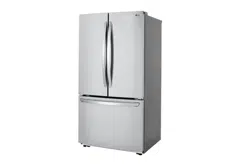Documents: Go to download!
- Owner's manual - (English, French, Spanish)
OWNER'S MANUAL Refrigerator
PRODUCT OVERVIEW
The images in this guide may be different from the actual components and accessories, which are subject to change by the manufacturer without prior notice for product improvement purposes.
Exterior

Interior
Standard Door : LFCC22426*
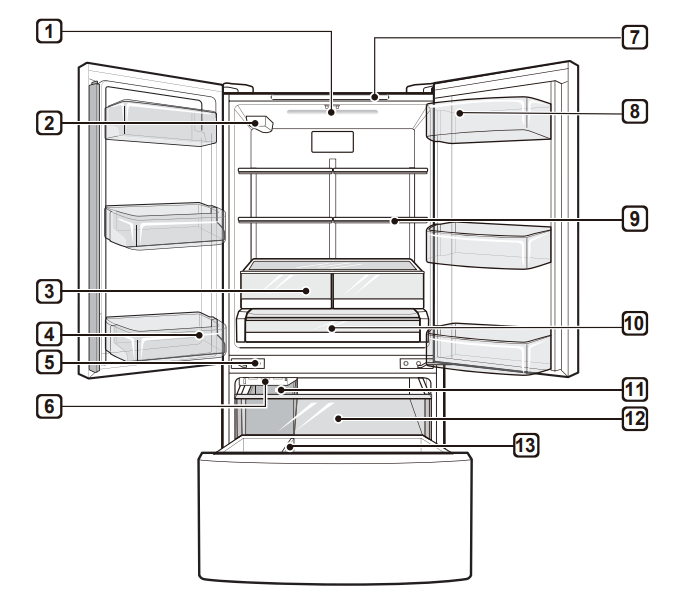

INSTALLATION
Installation Overview
Please read the following installation instructions first after purchasing this product or transporting it to another location.
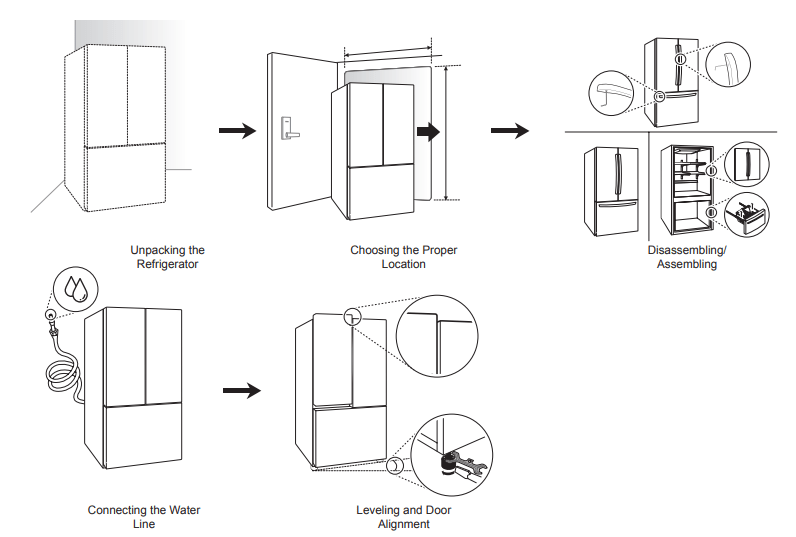
CAUTION
- Connect to potable water supply only.
- Fill with potable water only
Unpacking the Refrigerator
WARNING
- Use two or more people to move and install the refrigerator. Failure to do so can result in back injury or other injury.
- The refrigerator is heavy. Protect the floor when moving the refrigerator for cleaning or service. Always pull the refrigerator straight out when moving it. Do not wiggle or walk the refrigerator when trying to move it, as floor damage could occur.
- Keep flammable materials and vapors, such as gasoline, away from the refrigerator. Failure to do so can result in fire, explosion, or death.
NOTE
- Remove tape and any temporary labels from your refrigerator before using. Do not remove any warning labels, the model and serial number label, or the Tech Sheet that is located under the front of the refrigerator.
- To remove any remaining tape or glue, rub the area briskly with your thumb. Tape or glue residue can also be easily removed by rubbing a small amount of liquid dish soap over the adhesive with your fingers. Rinse with warm water and dry.
- Do not use sharp instruments, rubbing alcohol, flammable fluids, or abrasive cleaners to remove tape or glue. These products can damage the surface of your refrigerator.
- Reinstall or adjust shelves as needed. Refrigerator shelves are installed in the shipping position. Reinstall shelves according to your individual storage needs.
Choosing the Proper Location
Water
- Water supply must be easily connected for the automatic icemaker.
- NOTE: The water pressure must be 20 - 120 psi or 138 - 827 kPa or 1.4 - 8.4 kgf/cm2 . If the refrigerator is installed in an area with low water pressure (below 20 psi or 138 kPa or 1.4 kgf/cm2 ), you can install a booster pump to compensate for the low pressure
Electricity
- Use an individual, grounded outlet:115 Volts, 60 Hz, AC, 15 Amps minimum.
Flooring
- To avoid noise and vibration, the unit must be installed and leveled on a solidly constructed floor. If required, adjust the leveling legs to compensate for the unevenness of the floor.
- NOTE: Installing on carpeting, soft tile surfaces, a platform or weakly supported structure is not recommended.
Ambient
- Temperature Install this appliance in an area where the temperature is between 55 °F (13 °C) and 110 °F (43 °C).
- If the temperature around the appliance is too low or high, cooling ability may be adversely affected.
Dimensions and Clearances
- Check the dimensions of the appliance and the installation path to ensure there is sufficient room to move the refrigerator through doors or narrow openings.
- If an opening is too narrow to fit the refrigerator through, the doors must be removed.
- The installation location chosen for the refrigerator should allow space behind the unit for connections and airflow and space in front to open the doors and drawers.
- Too small of a distance from adjacent items may result in lowered freezing capability and increased electricity consumption charges. Allow at least 24 inches (610 mm) in front of the refrigerator to open the doors, and at least 2 inches (50.8 mm) between the back of the refrigerator and the wall.
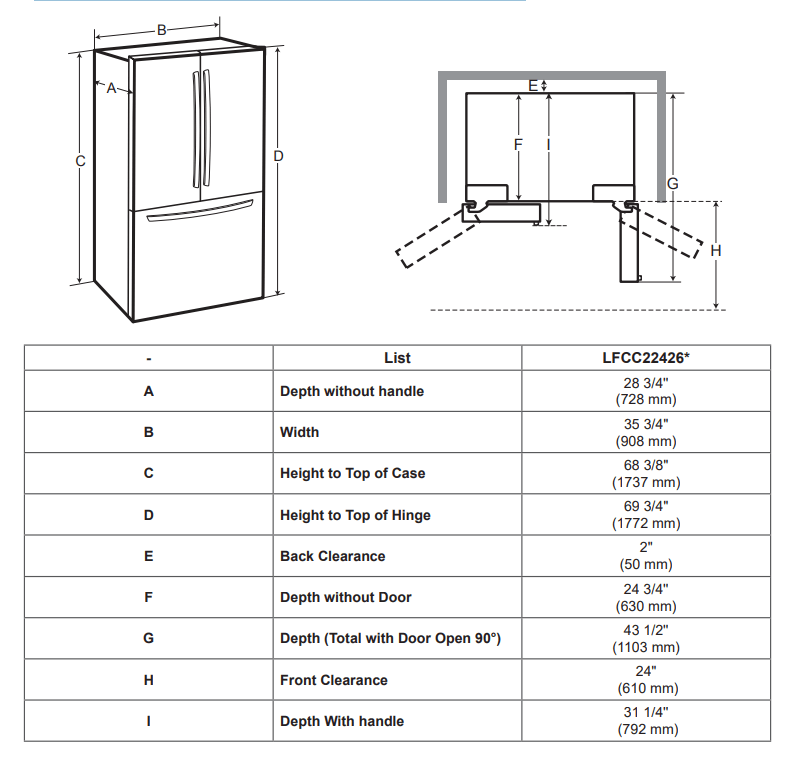
Removing/Assembling Handles
- When moving the refrigerator through a narrow opening, removing the doors is preferred.
- The appearance of the handles may vary from what is shown
When assembling or disassembling the refrigerator handles:
- Grasp the handle firmly to avoid dropping it.
- Do not swing the handle into nearby people or animals.
- Make sure that the bracket hole of the handle fits properly into the stopper bolt of the door. Assemble the set screws to fix the handle into place.
- Make sure that there is not a gap between the door and handle after assembling the handle.
Tools Needed
- 3/32 in. Allen wrench
- 1/8 in. Allen wrench
- 1/4 in. Allen wrench
Removing the Refrigerator Handles
- Loosen the set screws (1) with a 3/32 in. Allen wrench and remove the handle.
- Loosen the mounting fasteners (2) that connect to the refrigerator door and handle using a 1/4 in. Allen wrench, and remove the mounting fasteners.
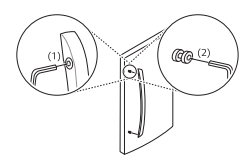
Assembling the Refrigerator Handles
- Assemble the mounting fasteners (1) at both ends of the handle with a 1/4 in. Allen wrench.
- Place the handle on the door by fitting the handle footprints over the mounting fasteners and tightening the set screws (2) with a 3/32 in. Allen wrench.
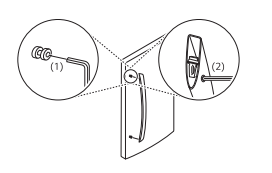
Removing the Freezer Drawer Handle
- Loosen the set screws (1) located on the lower side of the handle with a 1/8 in. Allen wrench and remove the handle.
- Loosen the mounting fasteners (2) with a 1/4 in. Allen wrench, and remove the mounting fasteners.

Assembling the Freezer Drawer Handle
- Assemble the mounting fasteners (1) at both ends of the handle with a 1/4 in. Allen wrench.
- Place the handle on the door by fitting the handle footprints over the mounting fasteners and tightening the set screws (2) with a 1/8 in. Allen wrench
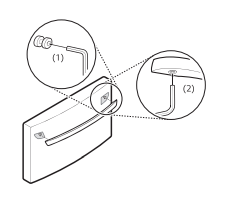
Removing/Assembling the Doors and Drawers
If the entrance door is too narrow for the refrigerator to pass through, remove the refrigerator doors and move the refrigerator sideways through the doorway.
Tools Needed
- 3/32 in. Allen wrench
- 1/8 in. Allen wrench
- 1/4 in. Allen wrench
Removing the Left Refrigerator Door
1 Open the door. Remove the top hinge cover screw and the hinge cover.

2 Disconnect all the wire harnesses.
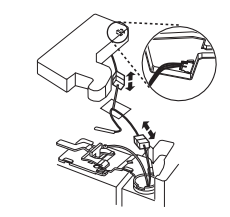
3 Rotate hinge lever counterclockwise. Lift the top hinge free of the hinge lever latch.

4 Lift the door from the middle hinge pin and remove the door
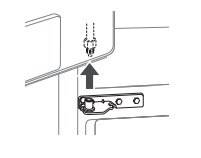
Removing the Right Refrigerator Door
1 Remove the top hinge cover screw (1). Lift the hook (not visible), located at the bottom of the front side of the cover (2), with a flat-head screwdriver.
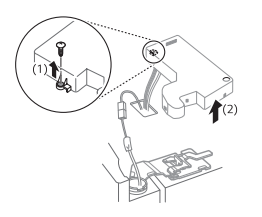
2 Detach the wire harness (1).
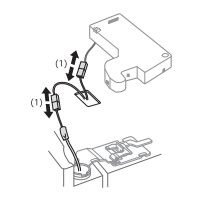
3 Rotate the hinge lever (1) clockwise. Lift the top hinge (2) free of the hinge lever latch.
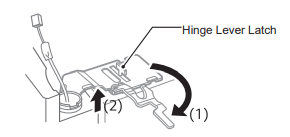
4 Lift the door from the middle hinge pin and remove the door.
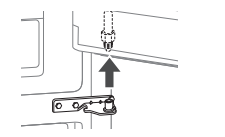
Assembling the Right Refrigerator Door
Install the right-side door first.
1 Make sure that the plastic sleeve is inserted in the bottom of the door. Lower the door onto the middle hinge pin as shown in the figure.
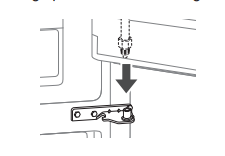
2 Fit the hinge (1) over the hinge lever latch and slot it into place. Rotate the lever (2) counterclockwise to secure the hinge.
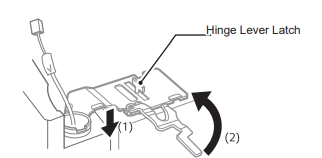
3 Connect the wire harness (1).

4 Place the cover (1) in its place. Insert and tighten the cover screw (2).
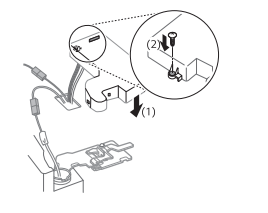
Assembling the Left Refrigerator Door
Install the left refrigerator door after the right door is installed.
1 Make sure that the plastic sleeve is inserted in the bottom of the door. Install the refrigerator door onto the middle hinge.
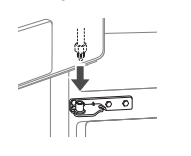
2 Rotate the hinge lever clockwise. Lift the top hinge free of the hinge lever latch.
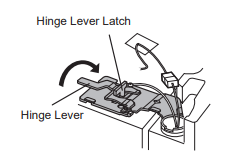
3 Connect all the wire harnesses.
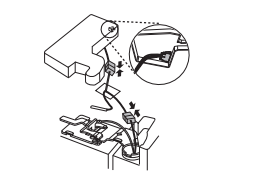
4 Place the hinge cover in place. Insert and tighten the cover screw.

NOTE: Disassembling/Assembling the Water Lines
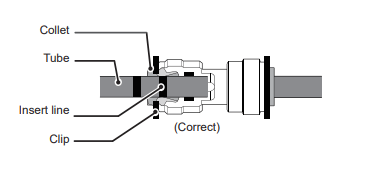
- Gently press the collet and insert the tube until only one line shows on the tube.
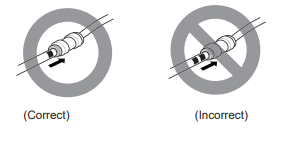
Removing the Freezer Drawers
- For models with two freezer drawers, remove both drawers in the same way.
- The Pullout Drawer located above the freezer drawer is not shown for clarity.
WARNING: To reduce the risk of electric shock, injury to persons, and death, follow basic precautions, including the following:
- Use two or more people to remove and install the refrigerator doors and freezer drawer.
- Be careful of sharp hinges on both sides of the drawer.
- When you lay the drawer down, be careful not to damage the floor.
- Do not sit or stand on the freezer drawer.
- To prevent accidents, keep children and pets away from the drawer. Do not leave the drawer open. If the Durabase® storage bin is removed from the freezer drawer, there is sufficient space for a small child or pet to crawl inside.

1 Pull the drawer open to full extension.
2 Gently lift and pull out the ice bin.
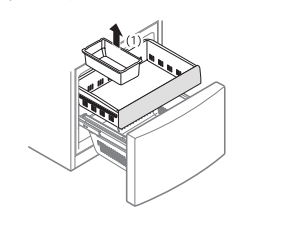
3 Lift the front of the drawer up, then pull it straight out.
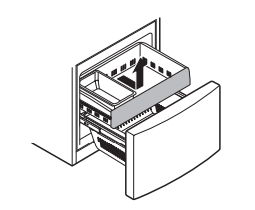
4 Remove the Durabase basket from the rails. Remove the screws from the rails at both ends.
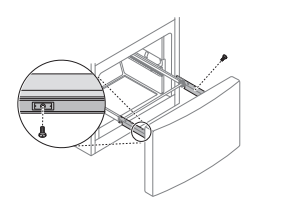
5 Grip both sides of the drawer and pull it up to remove it from the rails.

6 Hold both rails and push them in simultaneously.
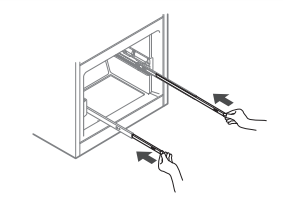
Assembling the Freezer Drawers
1 Pull out both rails simultaneously, until they are fully extended.
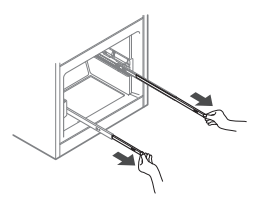
2 Grasp the drawer on each side and hook the drawer supports into the rail tabs located on both sides.
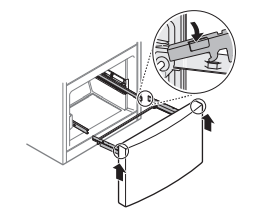
3 Lower the door into its final position and tighten the screws located on both sides.
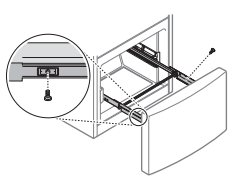
4 Push the drawer back until it clicks into place.
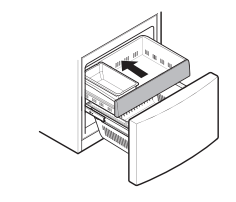
5 Replace the ice bin in the drawer. Insert the Durabase basket in the rail assembly.

Connecting the Water Line
Before Beginning: This water line installation is not covered by the refrigerator warranty. Follow these instructions carefully to minimize the risk of expensive water damage. If necessary, call a qualified plumber to correct water hammer before installing the water supply line to the refrigerator. Water banging in the pipes, or water hammer in residential plumbing can cause damage to refrigerator parts and lead to water leakage or flooding.
- Turn the icemaker OFF if the refrigerator will be used before the water line is connected.
- Do not install the icemaker tubing in areas where the ambient temperatures fall below freezing.
WARNING: Connect to potable water supply only.
CAUTION
- To prevent burns and product damage, only connect the refrigerator water line to a cold water supply.
- Wear eye protection during installation to prevent injury.
Water Pressure: You will need a cold water supply.

If the water pressure from the reverse osmosis system is less than 20 psi or 138 kPa or 1.4 kgf/ cm2 (takes more than 4 seconds to fill a cup of 7 oz or 198 cc capacity):
- Check to see if the sediment filter in the reverse osmosis system is blocked. Replace the filter if necessary.
- Allow the storage tank on the reverse osmosis system to refill after heavy usage.
- If the water pressure remains low, call a licensed, qualified plumber.
- All installations must be in accordance with local plumbing code requirements.
Supplies Needed
- Copper or PEX Tubing, ¼ in. outer diameter, to connect the refrigerator to the water supply. Be sure both ends of the tubing are cut square. To determine how much tubing you need, measure the distance from the water valve on the back of the refrigerator to the water supply pipe. Then, add 8 feet (2.4 m). Be sure there is sufficient extra tubing (about 8 feet [2.4 m] coiled into 3 turns of about 10 in. [25 cm] diameter) to allow the refrigerator to move out from the wall after installation.
- Power drill.
- ½ in. or adjustable wrench.
- Flat-blade and Phillips-head screwdrivers.
- Two ¼ in. outer diameter compression nuts and 2 ferrules (sleeves) to connect the copper tubing to the shutoff valve and the refrigerator water valve.
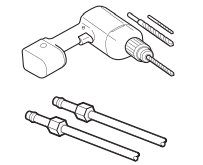
- If your existing copper water line has a flared fitting at the end, purchase an adapter (available at plumbing supply stores) to connect the water line to the refrigerator OR cut off the flared fitting with a tube cutter and then use a compression fitting.
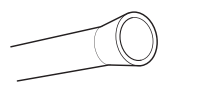
- Shutoff valve to connect to the cold water line. The shutoff valve should have a water inlet with a minimum inside diameter of 5/32 in. at the point of connection to the COLD WATER LINE. Saddle-type shutoff valves are included in many water supply kits. Before purchasing, make sure a saddle-type valve complies with your local plumbing codes.

Water Line Installation Instructions
WARNING - Electric Shock Hazard: When using any electrical device (such as a power drill) during installation, be sure the device is battery-powered, double-insulated or grounded in a manner that will prevent the hazard of electric shock.
Install the shutoff valve on the nearest frequently used drinking water line.
1 Shut off the main water supply. Turn on the nearest faucet to relieve the pressure on the line.
2 Choose the valve location. Choose a location for the valve that is easily accessible. It is best to connect into the side of a vertical water pipe. When it is necessary to connect into a horizontal water pipe, make the connection to the top or side, rather than at the bottom, to avoid drawing off any sediment from the water pipe.
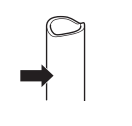
3 Drill the hole for the valve. Drill a ¼ in. hole in the water pipe using a sharp bit. Remove any burrs resulting from drilling the hole in the pipe. Be careful not to allow water to drain into the drill. Failure to drill a ¼ in. hole may result in reduced ice production or smaller cubes.
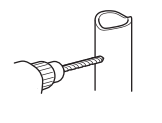
4 Fasten the shutoff valve. Fasten the shutoff valve to the cold water pipe with the pipe clamp
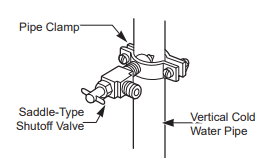
5 Tighten the pipe clamp. Tighten the clamp screws until the sealing washer begins to swell.
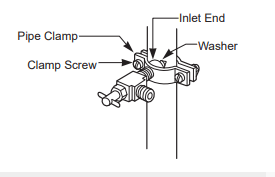
6 Route the tubing. Route the tubing between the cold water line and the refrigerator. Route the tubing through a hole drilled in the wall or floor (behind the refrigerator or adjacent base cabinet) as close to the wall as possible.
7 Connect the tubing to the valve. Place the compression nut and ferrule (sleeve) for copper tubing onto the end of the tubing and connect it to the shutoff valve. Make sure the tubing is fully inserted into the valve. Tighten the compression nut securely
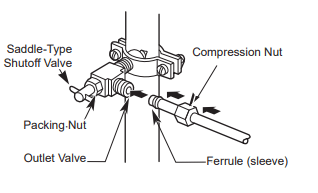
8 Flush out the tubing. Turn the main water supply on and flush out the tubing until the water is clear. Shut the water off at the water valve after about one quart of water has been flushed through the tubing.
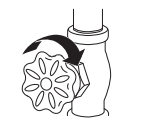
9 Connect the tubing to the refrigerator
NOTE
- Before making the connection to the refrigerator, be sure that the refrigerator power cord is not plugged into the wall outlet.
- Remove the plastic flexible cap from the water valve.
- Place the compression nut and ferrule (sleeve) onto the end of the tubing as shown.
- Insert the end of the copper tubing into the connection as far as possible. While holding the tubing, tighten the fitting

10 Turn the water on at the shutoff valve. Tighten any connections that leak.
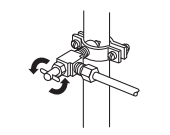
Leveling and Door Alignment
Leveling: The refrigerator has two front leveling legs. Adjust the legs to alter the tilt from front-to-back or side-to side. If the refrigerator seems unsteady, or the doors do not close easily, adjust the refrigerator’s tilt using the instructions below:
1 Turn the leveling leg to the left to raise that side of the refrigerator or to the right to lower it. It may take several turns of the leveling leg to adjust the tilt of the refrigerator
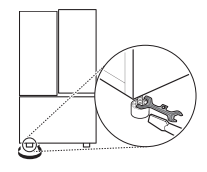
NOTE: A flare nut wrench works best, but an open-end wrench will suffice. Do not over-tighten.
2 Open both doors and check to make sure that they close easily. If the doors do not close easily, tilt the refrigerator slightly more to the rear by turning both leveling legs to the left. It may take several more turns, and be sure to turn both leveling legs the same amount.
Door Alignment
- Both the left and right refrigerator doors have an adjustable nut, located on the bottom hinge, to raise and lower them to align properly.
- If the space between the doors is uneven, follow the instructions below to align the doors evenly:
- Use the wrench (included with the owner's manual) to turn the nut in the door hinge to adjust the height. Turn the nut to the right to raise the door or to the left to lower it
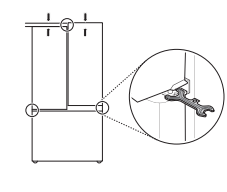
Turning on the Power
- After installing, plug the refrigerator’s power cord into a 3-prong grounded outlet and push the refrigerator into the final position.
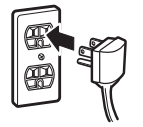
CAUTION
- Connect to a rated power outlet.
- If necessary, have a qualified electrician check the wall outlet and wiring for proper grounding.
- Do not damage or cut off the ground terminal of the power plug
Position the Refrigerator
- Arrange the coil of tubing so that it does not vibrate against the back of the refrigerator or against the wall. Push the refrigerator back to the wall.
Start the Icemaker
- If the water line is connected, set the icemaker power switch to the ON position.
- The icemaker will not begin to operate until it reaches its operating temperature of 15 °F (–9 °C) or below. It will then begin operation automatically if the icemaker power switch is in the ON (I) position.
OPERATION
Before Use
 Clean the refrigerator. Clean the refrigerator thoroughly and wipe off all dust that accumulated during shipping.
Clean the refrigerator. Clean the refrigerator thoroughly and wipe off all dust that accumulated during shipping.
CAUTION
- Wipe adhesive residue off with your thumb or dish detergent. Do not use sharp objects or abrasive, flammble, or a alcohol-based cleaners.
- Do not peel off the model or serial number label or the technical information on the rear surface of the refrigerator.
 Open refrigerator and freezer doors to ventilate the interior. The inside of the refrigerator may smell like plastic at first. Remove any adhesive tape from inside the refrigerator and open the refrigerator doors and the freezer drawers for ventilation.
Open refrigerator and freezer doors to ventilate the interior. The inside of the refrigerator may smell like plastic at first. Remove any adhesive tape from inside the refrigerator and open the refrigerator doors and the freezer drawers for ventilation.
 Connect the power supply. Check if the power supply is connected before use. Read the “Turning On The Power” section.Wait for the refrigerator to cool. Allow the refrigerator to run for at least two to three hours before putting food in it. Check the flow of cold air in the freezer compartment to ensure proper cooling.
Connect the power supply. Check if the power supply is connected before use. Read the “Turning On The Power” section.Wait for the refrigerator to cool. Allow the refrigerator to run for at least two to three hours before putting food in it. Check the flow of cold air in the freezer compartment to ensure proper cooling.
CAUTION: Putting food in the refrigerator before it has cooled could cause the food to spoil, or a bad odor to remain inside the refrigerator.
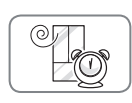 The refrigerator makes a loud noise after initial operation. This is normal. The volume will decrease as the temperature decreases.
The refrigerator makes a loud noise after initial operation. This is normal. The volume will decrease as the temperature decreases.
Control Panel
Depending on the model, some of the following functions may not be available.
Control Panel Features

1. Freezer Temperature
- Indicates the set temperature of the freezer compartment in Celsius (°C) or Fahrenheit (°F). The default freezer temperature is 0°F (-18 °C). Press the Freezer button repeatedly to select a new set temperature from -6 °F to 8 °F (-21 °C to -13 °C).
2. Refrigerator Temperature
- Indicates the set temperature of the refrigerator compartment in Celsius (°C) or Fahrenheit (°F).
- The default refrigerator temperature is 37 °F (3 °C). Press the Refrigerator button repeatedly to select a new set temperature from 33 °F to 46 °F (1 °C to 8 °C).
NOTE
- To change the temperature mode from °F to °C (or vice versa) press and hold the Refrigerator and Freezer Temperature buttons simultaneously for approximately five seconds. The temperature indicator on the display window switches between Celsius and Fahrenheit.
- The displayed temperature is the target temperature, and not the actual temperature of the refrigerator. The actual refrigerator temperature depends on the food inside the refrigerator.
3. Water Filter: Replace the water filter when the Replace Filter icon turns on. After replacing the water filter, press and hold the Water Filter button for three seconds to turn the icon light off. Replace the water filter approximately every six months.
4. Ice Plus: This function increases both ice making and freezing capabilities.
- Press the Ice Plus button to illuminate the icon and activate the function for 24 hours. The function automatically shuts off after 24 hours.
- Stop the function manually by pressing the button once more.
CAUTION:
- Display Mode (For Store Use Only): The Display Mode disables all cooling in the refrigerator and freezer sections to conserve energy while on display in a retail store. When activated, OFF is displayed on the control panel and the display remains on for 20 seconds.
- To deactivate / activate: With either refrigerator door opened, press and hold the Refrigerator and Ice Plus buttons at the same time for five seconds. The control panel beeps and the temperature settings display to confirm that Display Mode is deactivated. Use the same procedure to activate Display Mode.
Automatic Icemaker

NOTE
- The automatic icemaker can automatically make 12 cubes at a time, 50-110 pieces within a 24 hour period if conditions are favorable. This amount may vary according to the environment (ambient temperature around the appliance, frequency of the door being opened, amount of food stored in the appliance, etc.).
- If the ice bin is completely filled with ice, ice production will stop.
- Sound of ice dropping into the ice bin is normal.
- The icemaker produces ice once approximately 48 hours have passed after the appliance is initially installed.
- Discard the first ice cubes produced after initial install.
- Ice cubes which are stored in the ice bin for a long time may clump together and be difficult to separate. If this happens, empty the ice bin completely and clean it before reinstalling it.
WARNING - Personal Injury Hazard
- DO NOT place fingers or hands on the automatic ice making mechanism while the refrigerator is plugged in.
- Do not keep the power turned on to the icemaker it can damage the icemaker.
CAUTION: Never store beverage cans or other items in the ice bin for the purpose of rapid cooling. Doing so may damage the icemaker or the containers may burst.
- To avoid personal injury, keep hands out of the ice door and passage.
Turning the Automatic Icemaker On or Off
To turn off the automatic icemaker, set the icemaker switch to OFF (O). To turn on the automatic icemaker, set the switch to ON (I).
NOTE
- The icemaker water valve will buzz as the icemaker fills with water. If the power switch is in the ON (I) position, it will buzz even if it has not yet been hooked up to water. To stop the buzzing, move the power switch to OFF (O).
- The icemaker water valve buzzes as the icemaker fills with water. If the Ice On/Off button is in the ON mode, it will buzz even if it has not yet been hooked up to water. To stop the buzzing, press the Ice On/ Off button to turn it off.
- You will hear the sound of cubes dropping into the bin and water running in the pipes as the icemaker refills.
Preparing for Vacation
- Set the icemaker power switch to OFF (O) and shut off the water supply to the appliance.
- NOTE
- The ice bin should be emptied any time the icemaker on/off switch is turned to the OFF (O) position.
- If the ambient temperature will drop below freezing, have a qualified technician drain the water supply system to prevent serious property damage due to flooding caused by ruptured water lines or connections.
- If the ambient temperature will drop below freezing, have a qualified technician drain the water supply system to prevent serious property damage due to flooding caused by ruptured water lines or connections.
Humidity Controlled Crispers (On Some Models)
The crispers provide fresher tasting fruit and vegetables by letting you easily control humidity inside the drawer.
You can control the amount of humidity in the moisture-sealed crispers by adjusting the control to any setting between Vegetables and Fruit.
- Vegetables keeps moist air in the crisper for best storage of fresh, leafy vegetables.
- Fruit lets moist air out of the crisper for best storage of fruit.
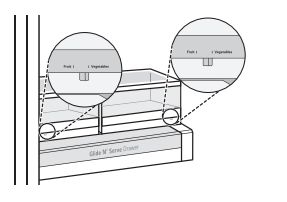
Durabase®
- The Durabase® divider allows you to organize the Durabase® area into sections. It can be adjusted from side to side to accommodate items of different sizes
- WARNING: If the Durabase® divider is removed, there is enough open space for children or pets to crawl inside. To prevent accidental child and pet entrapment or suffocation risk, DO NOT allow children or pets to touch or go near the drawer.
Glide"N"Serve (On Some Models)
- a variable temperature control that can keep the compartment at a slightly different temperature than the refrigerator section. This drawer can be used for large party trays, deli items and beverages. (This drawer should not be used to store vegetables that require high humidity.)
- Press the Select button to choose between Produce (Cold), Deli (Colder) and Meat (Coldest).
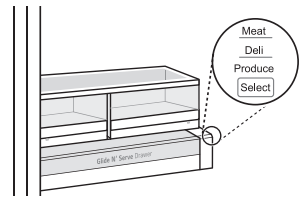
Detaching/Assembling the storage Bins
Some bins may vary in appearance and will only fit in one location
Glide"N"Serve and Crispers
1 To remove the humidity controlled crispers and the Glide'N'Serve, pull out the crisper (1) or Glide'N'Serve (2) to full extension, lift the front up, and pull straight out
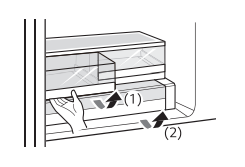
2 To install, slightly tilt up the front, insert the crisper or drawer into the frame and push it back into place
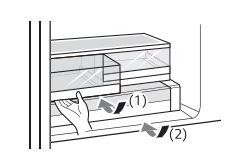
Crisper Cover
- To remove, lift the front of the cover up until it detaches from the back wall of the cabinet, then pull it out
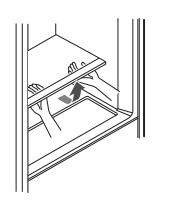
Door bins
The door bins are removable for easy cleaning and adjustment
1 To remove the bin, simply lift the bin up and pull straight out
2 To replace the bin, slide it in above the desired support and push down until it snaps into place
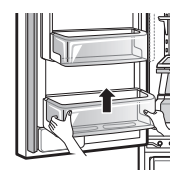
Adjusting the Refrigerator Shelves
- The shelves in the refrigerator are adjustable to meet individual storage needs. Your model may have full or split shelves.
- Adjusting the shelves to fit items of different heights will make finding the exact item you want easier.
Detaching the Shelf (Half Shelf Type)
1 Tilt up the front of the shelf and then lift the shelf straight up.
2 Pull the shelf out.
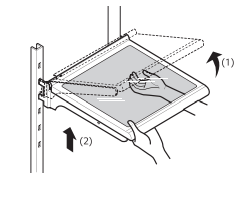
Assembling the Shelf (Half Shelf Type)
1 Tilt the front of the shelf up and guide the shelf hooks into the slots at a desired height.
2 Lower the front of the shelf so that the hooks drop into the slots
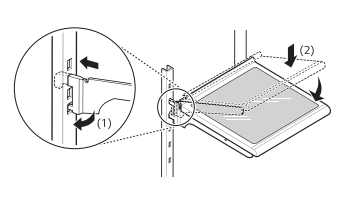
Using the Folding Shelf (On Some Models)
- Store taller items, such as a gallon container or bottles, by pushing the front half of the shelf underneath the back half of the shelf. Pull the front of the shelf forward to return to a full shelf.
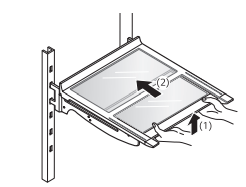
SMART FUNCTIONS
Smart Diagnosis™ Function
- Should you experience any problems with the appliance, it has the capability of transmitting data via your telephone to the LG Customer Information Center. NFC or Wi-Fi equipped models can also transmit data to a smartphone using the LG Smart ThinQ application
Smart Diagnosis™ through the Customer Information Center
For appliances with the  or
or  logo: This method allows you to speak directly to our trained specialists. The specialist records the data transmitted from the appliance and uses it to analyze the issue, providing a fast and effective diagnosis.
logo: This method allows you to speak directly to our trained specialists. The specialist records the data transmitted from the appliance and uses it to analyze the issue, providing a fast and effective diagnosis.
1 Call the LG Electronics Customer Information Center
2 Open the right refrigerator door.
3 Hold the mouthpiece of your phone in front of the speaker that is located on the right hinge of the refrigerator door, when instructed to do so by the call center.
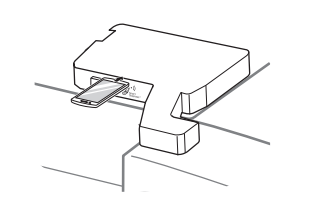
4 Press and hold the Freezer button for three seconds while continuing to hold your phone to the speaker.

5 After you hear three beeps, release the Freezer button.
6 Keep the phone in place until the tone transmission has finished. The display will count down the time. Once the countdown is over and the tones have stopped, resume your conversation with the specialist, who will then be able to assist you in using the information transmitted for analysis.
NOTE
- For best results, do not move the phone while the tones are being transmitted.
- If the call center agent is not able to get an accurate recording of the data, you may be asked to try again.
- The Smart Diagnosis™ function depends on the local call quality.
- Bad call quality may result in poor data transmission from your phone to the call center, which could cause Smart Diagnosis™ to malfunction.
LG SmartThinQ Smart Diagnosis™
For appliances with the  or
or  logo
logo
- Use the Smart Diagnosis feature in the LG SmartThinQ application for help diagnosing issues with the appliance without the assistance of the LG Customer Information Center.
- Follow the instructions in the LG SmartThinQ application to perform a Smart Diagnosis using your smartphone.
MAINTENANCE
Cleaning
WARNING: Use non-flammable cleaner. Failure to do so can result in fire, explosion, or death.
CAUTION
- Do not use an abrasive cloth or sponge when cleaning the interior and exterior of the refrigerator.
- Do not place your hand on the bottom surface of the refrigerator when opening and closing the doors.
- When lifting the hinge free of the latch, be careful that the door does not fall forward.
General Cleaning Tips
- Both the refrigerator and freezer sections defrost automatically; however, clean both sections once a month to prevent odors.
- Wipe up spills immediately.
- Unplug the refrigerator or disconnect power before cleaning.
- Remove all removable parts, such as shelves.
- Use a clean sponge or soft cloth and a mild detergent in warm water. Do not use abrasive or harsh cleaners.
- Hand wash, rinse and dry all surfaces thoroughly.
- When cleaning the inside or outside of the appliance, do not wipe it with a rough brush, toothpaste, or flammable materials. Do not use cleaning agents containing flammable substances.
- This may cause discoloration or damage to the appliance.
- Flammable substances: alcohol (ethanol, methanol, isopropyl alcohol, isobutyl alcohol, etc.), thinner, bleach, benzene, flammable liquid, abrasive, etc.
Exterior
- Waxing external painted metal surfaces helps provide rust protection. Do not wax plastic parts. Wax painted metal surfaces at least twice a year using appliance wax (or auto paste wax). Apply wax with a clean, soft cloth.
- For products with black stainless steel exterior, spray glass cleaner on a clean, microfiber cloth and rub in direction of grain. Do not spray glass cleaner directly at the display panel. Do not use harsh or abrasive cleaners.
- For products with a standard stainless steel exterior, use a damp microfiber cloth and rub in the direction of the grain. Dry with a paper towel to avoid streaks. For stubborn stains and fingerprints, use a few drops of liquid dish soap in water, and rinse with hot water before drying. Do not use abrasive or harsh cleaners.
Inside Walls
- Allow freezer to warm up so the cloth will not stick. To help remove odors, wash the inside of the refrigerator with a mixture of baking soda and warm water. Mix 2 tablespoons of baking soda to 1 quart of water (26 g soda to 1 liter water.) Be sure the baking soda is completely dissolved so it does not scratch the surfaces of the refrigerator.
Door Liners and Gaskets
- Use a clean sponge or soft cloth and a mild detergent in warm water. Do not use cleaning waxes, concentrated detergents, bleaches, or cleaners containing petroleum on plastic refrigerator parts.
Plastic Parts (covers and panels)
- Use a clean sponge or soft cloth and a mild detergent in warm water. Do not use glass cleaners, abrasive cleansers, or flammable fluids. These can scratch or damage the material.
Condenser Coils
- Use a vacuum cleaner with a brush or crevice attachment to clean the condenser cover and vents. Do not remove the panel covering the condenser coil area.
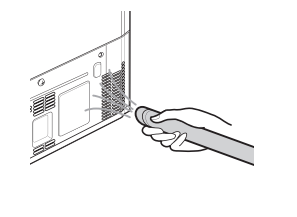
Replacing the Fresh Air Filter
Replace the Fresh Air Filter:
- Approximately every six months.
- When the Replace Filter
 icon turns on
icon turns on
1 Hold and remove the filter cover by rotating it counterclockwise until the hooks 1 are separated completely
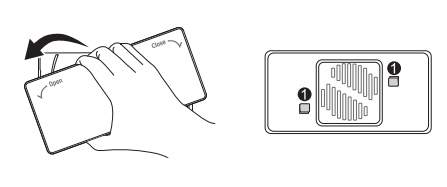
2 Remove the filter from the cover. Place the new filter inside of the cover with the side that says Front facing outward.
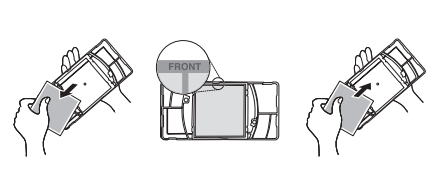
3 Hold and refit the air filter cover by rotating it clockwise until the hooks are engaged completely.
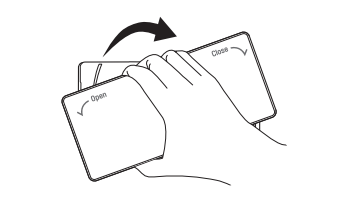
4 Press and hold the Fresh Air Filter button for three seconds to reset the filter sensor
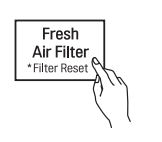
Replacing the Water Filter
Replace the Water Filter :
- Approximately every six months.
- When the Replace Filter icon turns on.
- When the water dispenser output decreases.
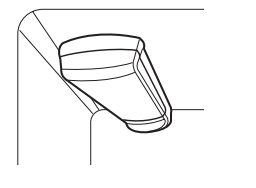
Before Replacing the Water Filter: If the top shelf, located below the water filter, is in the highest position, it will need to be removed prior to replacing the water filter. To remove any shelf : Tilt up the front of the shelf (1) and lift (2). Pull the shelf out.
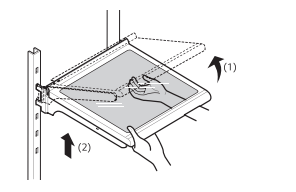
1 Remove the old water filter. Lower or remove the top left shelf to allow the water filter to rotate all the way down. Pinch the sides to open the water filter cover.
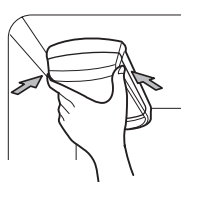
NOTE
- Replacing the water filter causes a small amount of water (around 1 oz. or 25 cc) to drain.
- Wrap a cloth around the front end of the water filter cover to collect any leaking water. Hold the water filter upright, once it is removed, to prevent any remaining water from spilling out of the water filter.
2 Pull the water filter downward and turn it counterclockwise before pulling it out. Make sure to rotate the filter down completely before pulling it out of the manifold hole.
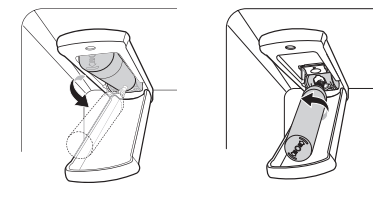
3 Replace with a new water filter. Take the new water filter out of its packing and remove the protective cover from the o-rings. With the water filter tabs in the horizontal position, push the new water filter into the manifold hole and turn it clockwise until it stops.
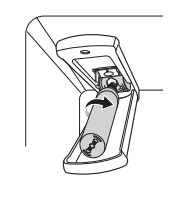
4 Close the water filter cover. The cover will click when closed correctly.
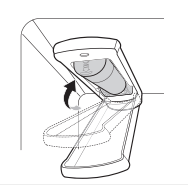
5 After the water filter is replaced, dispense 2.5 gallons of water (flush for approximately 5 minutes) to remove trapped air and contaminants from the system.
NOTE: Do not dispense the entire 2.5 gallon amount continuously. Press and release the dispenser pad for cycles of 30 seconds ON and 60 seconds OFF.
6 After changing the filter, press and hold the Water Filter button for three seconds to reset the indicator light.
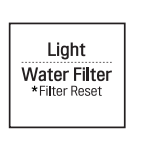
Performance Data Sheet:
Model: LT1000P Use Replacement Cartridge: ADQ747935**
The concentration of the indicated substances in water entering the system was reduced to a concentration less than or equal to the permissible limit for water leaving the system as specified in NSF/ANSI Standard 42 and Standard 53.
 System tested and certified by NSF International against NSF/ANSI Standard 42, Standard 53 and Standard 401 for the reduction of substances listed below
System tested and certified by NSF International against NSF/ANSI Standard 42, Standard 53 and Standard 401 for the reduction of substances listed below
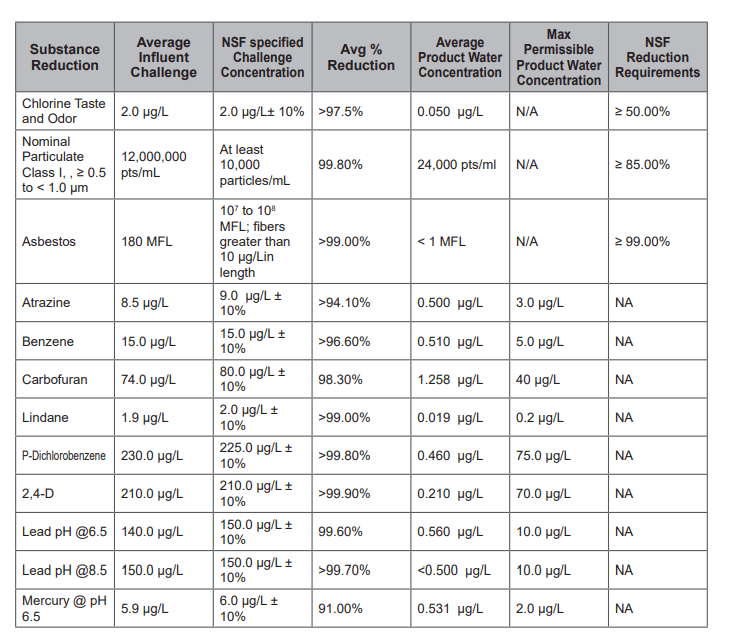
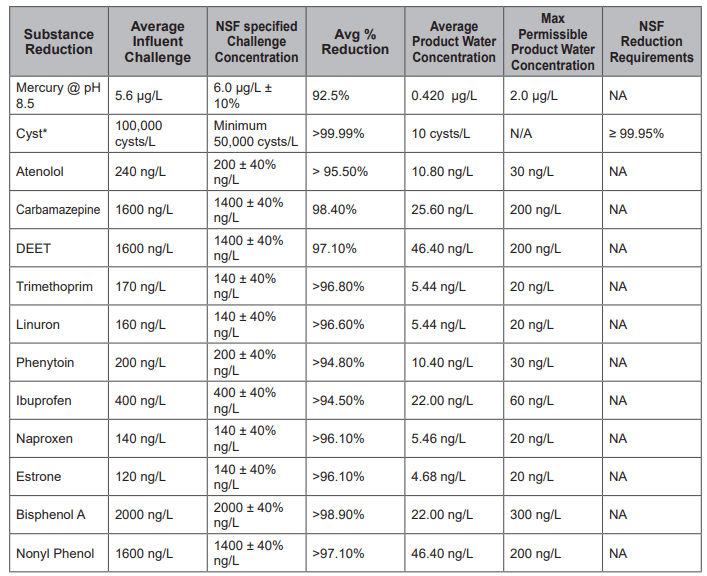

- It is essential that the manufacturer’s recommended installation, maintenance and filter replacement requirements be carried out for the product to perform as advertised.
- NOTE: While the testing was performed under standard laboratory conditions, actual performance may vary
WARNING
- To reduce the risk associated with choking: Do not allow children under 3 years of age to have access to small parts during the installation of this product.
- To reduce the risk associated with the ingestion of contaminants: Do not use with water that is microbiologically unsafe or of unknown quality without adequate disinfection before or after the system. Systems certified for cyst reduction may be used on disinfected water that may contain filterable cysts. EPA Establishment # 070595-MEX-001
CAUTION -To reduce the risk associated with property damage due to water leakage:
- Read and follow Use Instructions before installation and use of this system.
- Installation and use MUST comply with all state and local plumbing codes.
- Do not install if water pressure exceeds 120 psi (827 kPa). If your water pressure exceeds 80 psi, you must install a pressure limiting valve. Contact a plumber if uncertain how to check your water pressure.
- Do not install where water hammer conditions may occur. If water hammer conditions exist you must install a water hammer arrester. Contact a plumbing professional if you are uncertain how to check for this condition.
- Do not install on hot water supply lines. The maximum operating water temperature of this filter system is 100 °F (37.8 °C).
- Protect filter from freezing. Drain filter when temperatures drop below 40 °F (4.4 °C).
- The disposable filter cartridge MUST be replaced every 6 months, at the rated capacity or if a noticeable reduction in flow rate occurs.
- Protect from freezing, remove filter cartridge when temperatures are expected to drop below 33° F.
- Do not install systems in areas where ambient temperatures may go above 110° F (43.3° C).
- Where a backflow prevention device is installed on a water system, a device for controlling pressure due to thermal expansion must be installed.
- Ensure all tubing and fittings are secure and free of leaks.
TROUBLESHOOTING
FAQs: Frequently Asked Questions
1. Q: What are the best temperature settings for my refrigerator and freezer?
- A: The default setting for the refrigerator is 37° Fahrenheit (3° Celsius). The default setting for the freezer is 0° Fahrenheit (-18° Celsius). Adjust these settings as necessary to keep food at desired temperatures. Milk should be cold when stored on the inner shelf of the refrigerator. Ice cream should be firm and ice cubes should not melt in the freezer. To switch the display from Fahrenheit to Celsius, press and hold the Freezer and Refrigerator buttons until you hear a beep and the settings in the display change. On some models, you can also select the Refrigerator Manager application on the display and use the Unit button.
2. Q: How do I set the refrigerator and freezer temperatures?
- A: Continually press the Refrigerator or Freezer button on the control panel until the desired temperature appears. The numbers will cycle from highest to lowest and then return to the highest again with continuous pressing. On some models, you can also set the temperatures in the Refrigerator Manager application on the display.
3. Q: Why do I hear a buzzing noise from my refrigerator periodically?
- A: This may happen if you do not have a water source attached to your refrigerator and the icemaker is turned on. If you do not have a water source attached to the back of the refrigerator you should turn the icemaker off.
4. Q: Why does the icemaker tray look crooked?
- A: This is a normal part of the icemaker cycle. The icemaker tray may appear level or with a slight tilt. The change in position is to assist in the freezing process.
5. Q: My refrigerator is powered on and the controls are working, but it’s not cooling and the display shows “OFF” (see below). What is wrong?
- A: The refrigerator is in Demo Mode. This mode disables cooling to save energy while the appliance is on display in a store. To restore normal operation, press and hold the Refrigerator and Ice Plus buttons for 5 seconds or until you hear a beep and the temperature settings appear on the display. Use the same procedure to return the refrigerator to Demo Mode, if desired.
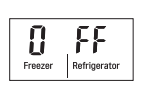
Before Calling for Service
Review this section before calling for service; doing so will save you both time and money.
Cooling
1. Refrigerator and Freezer section are not cooling.
- The refrigerator control is set to OFF (some models).
- Turn the control ON. Refer to the Setting the Controls section for proper temperature settings.
- Refrigerator is set to Demo Mode.
- Demo Mode allows the lights and control display to work normally while disabling cooling, to save energy while the refrigerator is on the showroom floor. See the FAQs section of this manual for instructions on how to disable Demo Mode.
- Refrigerator is in the defrost cycle.
- During the defrost cycle, the temperature of each compartment may rise slightly. Wait 30 minutes and confirm the proper temperature has been restored once the defrost cycle has completed.
- Refrigerator was recently installed.
- It may take up to 24 hours for each compartment to reach the desired temperature.
- Refrigerator was recently relocated.
- If the refrigerator was stored for a long period of time or moved on its side, it is necessary for the refrigerator to stand upright for 24 hours before connecting it to power.
2. Cooling system runs too much.
- Refrigerator is replacing an older model.
- Modern refrigerators require more operating time but use less energy due to more efficient technology.
- Refrigerator was recently plugged in or power restored.
- The refrigerator will take up to 24 hours to cool completely.
- The door is opened often or a large amount of food / hot food was added.
- Adding food and opening the door warms the refrigerator, requiring the compressor to run longer in order to cool the refrigerator back down. In order to conserve energy, try to get everything you need out of the refrigerator at once, keep food organized so it is easy to find, and close the door as soon as the food is removed. (Refer to the Food Storage Guide.)
- Doors are not closed completely.
- Firmly push the doors shut. If they will not shut all the way, the "Doors will not close correctly or pop open" section.
- Refrigerator is installed in a hot location.
- The compressor will run longer under warm conditions. At normal room temperatures (70 °F) expect your compressor to run about 40 % to 80 % of the time. Under warmer conditions, expect it to run even more often. The refrigerator should not be operated above 110 °F.
- Condenser / back cover is clogged.
- Use a vacuum cleaner with an attachment to clean the condenser cover and vents. Do not remove the panel covering the condenser coil area.
3. Interior moisture buildup.
- Doors are opened often or for long periods of time.
- When the doors are opened often or for long periods of time, warm, humid air enters the compartment. This raises the temperature and moisture level within the compartment. To lessen the effect, reduce the frequency and duration of door openings.
- Doors are not closed correctly.
- See the "Doors will not close correctly or pop open" section.
- Weather is humid.
- Humid weather allows additional moisture to enter the compartments when the doors are opened leading to condensation or frost. Maintaining a reasonable level of humidity in the home will help to control the amount of moisture that can enter the compartments.
- Defrost cycle recently completed.
- During the defrost cycle, the temperature of each compartment may rise slightly and condensation may form on the back wall. Wait 30 minutes and confirm that the proper temperature has been restored once the defrost cycle has completed.
- Food is not packaged correctly.
- Food stored uncovered or unwrapped, and damp containers can lead to moisture accumulation within each compartment. Wipe all containers dry and store food in sealed packaging to prevent condensation and frost.
4. Food is freezing in the refrigerator compartment.
- Food with high water content was placed near an air vent.
- Rearrange items with high water content away from air vents.
- Refrigerator temperature control is set incorrectly.
- If the temperature is too cold, adjust the control one increment at a time and wait for the temperature to stabilize. Refer to the Control Panel section for more information.
- Refrigerator is installed in a cold location.
- When the refrigerator is operated in temperature below 41°F (5°C), food can freeze in the refrigerator compartment. The refrigerator should not be operated in temperature below 55°F (13°C)
5. Refrigerator or Freezer section is too warm.
- Refrigerator was recently installed.
- It may take up to 24 hours for each compartment to reach the desired temperature.
- The air vents are blocked. Cold air circulates from the freezer to the fresh food section and back again through air vents in the wall dividing the two sections.
- Locate air vents by using your hand to sense airflow and move all packages that block vents and restrict airflow. Rearrange items to allow air to flow throughout the compartment.
Cooling/Ice & Water
1. Refrigerator or Freezer section is too warm.
- Doors are opened often or for long periods of time.
- When the doors are opened often or for long periods of time, warm, humid air enters the compartment. This raises the temperature and moisture level within the compartment. To lessen the effect, reduce the frequency and duration of door openings.
- Unit is installed in a hot location.
- The refrigerator should not be operated in temperatures above 110 °F.
- A large amount of food or hot food was added to either compartment.
- Adding food warms the compartment requiring the cooling system to run. Allowing hot food to cool to room temperature before putting it in the refrigerator will reduce this effect.
- Doors not closed correctly.
- See the Doors will not close correctly or pop open section in Parts & Features Troubleshooting.
- Temperature control is not set correctly.
- If the temperature is too warm, adjust the control one increment at a time and wait for the temperature to stabilize.
- Defrost cycle has recently completed.
- During the defrost cycle, the temperature of each compartment may rise slightly and condensation may form on the back wall. Wait 30 minutes and confirm the proper temperature has been restored once the defrost cycle has completed
2. Refrigerator or Freezer section is too cold.
- Incorrect temperature control settings.
- If the temperature is too cold, adjust the control one increment at a time and wait for the temperature to stabilize. Refer to the Control Panel for more information
3. Frost or ice crystals form on frozen food (inside of sealed package).
- Condensation from food with a high water content has frozen inside of the food package.
- This is normal for food items with a high water content.
- Food has been left in the freezer for a long period of time.
- Do not store food items with high water content in the freezer for a long period of time.
4. Frost or ice crystals form on frozen food (outside of package).
- Door is opened frequently or for long periods of time.
- When the doors are opened often or for long periods of time, warm, humid air enters the compartment. This raises the temperature and moisture level within the compartment. Increased moisture will lead to frost and condensation. To lessen the effect, reduce the frequency and duration of door openings.
- Door is not closing properly.
- Refer to the Doors will not close correctly or pop open section in the Troubleshooting section.
Ice & Water
1. Icemaker is not making enough ice.
- Demand exceeds ice storage capacity.
- The icemaker will produce approximately 70-184 cubes in a 24 hour period.
- House water supply is not connected, valve is not turned on fully, or valve is clogged.
- Connect the refrigerator to a cold water supply with adequate pressure and turn the water shutoff valve fully open. If the problem persists, it may be necessary to contact a plumber.
- Water filter has been exhausted.
- Replacing the water filter is recommended:
- Approximately every six months.
- When the water filter indicator turns on.
- When the water dispenser output decreases.
- When the ice cubes are smaller than normal.
- Low house water supply pressure.
- The water pressure must be between 20 and 120 psi on models without a water filter and between 40 and 120 psi on models with a water filter. If the problem persists, it may be necessary to contact a plumber.
- Reverse Osmosis filtration system is used.
- Reverse osmosis filtration systems can reduce the water pressure below the minimum amount and result in icemaker issues. (Refer to the Connecting the Water Line section.)
- Tubing connecting refrigerator to house supply valve is kinked.
- The tubing can kink when the refrigerator is moved during installation or cleaning resulting in reduced water flow. Straighten or repair the water supply line and arrange it to prevent future kinks.
- Doors are opened often or for long periods of time.
- If the doors of the unit are opened often, ambient air will warm the refrigerator which will prevent the unit from maintaining the set temperature. Lowering the refrigerator temperature can help, as well as not opening the doors as frequently.
- Doors are not closed completely.
- If the doors are not properly closed, ice production will be affected. See the "Doors will not close correctly or pop open" section in Parts & Features Troubleshooting for more information.
- The temperature setting for the freezer is too warm.
- The recommended temperature for the freezer compartment for normal ice production is 0°F. If the freezer temperature is warmer, ice production will be affected.
2. Icemaker is not making ice
- Refrigerator was recently installed or icemaker recently connected.
- It may take up to 24 hours for each compartment to reach the desired temperature and for the icemaker to begin making ice.
- Icemaker not turned on.
- Locate the icemaker ON/OFF and confirm that it is turned on.
- The ice detecting sensor is obstructed.
- Foreign substances or frost on the ice-detecting sensor can interrupt ice production. Make sure that the sensor area is clean at all times for proper operation.
- The refrigerator is not connected to a water supply or the supply shutoff valve is not turned on.
- Connect the refrigerator to the water supply and turn the water shutoff valve fully open.
- Icemaker shutoff (arm or sensor) obstructed.
- If your icemaker is equipped with an ice shutoff arm, make sure that the arm moves freely. If your icemaker is equipped with the electronic ice shutoff sensor, make sure that there is a clear path between the two sensors.
- Reverse osmosis water filtration system is connected to your cold water supply.
- Reverse osmosis filtration systems can reduce the water pressure below the minimum amount and result in icemaker issues. (Refer to the Connecting the Water Line section.)
3. Ice has bad taste or odor.
- Water supply contains minerals such as sulfur.
- A water filter may need to be installed to eliminate taste and odor problems. NOTE: In some cases, a filter may not help. It may not be possible to remove all minerals/ odor/taste in all water supplies.
- Icemaker was recently installed.
- Ice that has been stored for too long will shrink, become cloudy, and may develop a stale taste. Throw away old ice and make a new supply.
- The food has not been stored properly in either compartment.
- Rewrap the food. Odors may migrate to the ice if food is not wrapped properly.
- The interior of the refrigerator needs to be cleaned.
- See the Maintenance section for more information.
- The ice storage bin needs to be cleaned.
- Empty and wash the bin (discard old cubes). Make sure that the bin is completely dry before reinstalling it.
4. Icemaker is making too much ice.
- Icemaker shutoff (arm/ sensor) is obstructed.
- Empty the ice bin. If your icemaker is equipped with an ice shutoff arm, make sure that the arm moves freely. If your icemaker is equipped with the electronic ice shutoff sensor, make sure that there is a clear path between the two sensors. Reinstall the ice bin and wait 24 hours to confirm proper operation.
Parts & Features
1. Doors will not close correctly or pop open.
- Food packages are blocking the door open.
- Rearrange food containers to clear the door and door shelves.
- Ice bin, crisper cover, pans, shelves, door bins, or baskets are out of position.
- Push bins all the way in and put crisper cover, pans, shelves and baskets into their correct positions. See the Operation section for more information.
- The doors were removed during product installation and not properly replaced.
- Remove and replace the doors according to the Removing and Replacing Refrigerator Handles and Doors section.
- Refrigerator is not leveled properly.
- See Door Alignment in the Refrigeration Installation section to level refrigerator
2. Doors are difficult to open.
- The gaskets are dirty or sticky.
- Clean the gaskets and the surfaces that they touch. Rub a thin coat of appliance polish or kitchen wax on the gaskets after cleaning.
- Door was recently closed.
- When you open the door, warmer air enters the refrigerator. As the warm air cools, it can create a vacuum. If the door is hard to open, wait one minute to allow the air pressure to equalize, then see if it opens more easily.
3. Refrigerator wobbles or seems unstable
- Leveling legs are not adjusted properly.
- Refer to the Leveling and Door Alignment section.
- Floor is not level.
- It may be necessary to add shims under the leveling legs or rollers to complete installation.
4. Lights do not work.
- LED interior lighting failure.
- The refrigerator compartment lamp is LED interior lighting, and service should be performed by a qualified technician.
5. Refrigerator has an unusual odor.
- The Air Filter may need to be set to the MAX setting or replaced.
- Set the Air Filter to the MAX setting. If the odor does not go away within 24 hours, the filter may need to be replaced. See the Replacing the Air Filter section for replacement instructions.
6. The interior of the refrigerator is covered with dust or soot.
- The refrigerator is located near a fire source, such as a fireplace, chimney, or candle.
- Make sure that the refrigerator is not located near a fire source, such as a fireplace, chimney or candle.
Noises
1. Clicking
- The defrost control will click when the automatic defrost cycle begins and ends. The thermostat control (or refrigerator control on some models) will also click when cycling on and off.
- Normal Operation
2. Rattling
- Rattling noises may come from the flow of refrigerant, the water line on the back of the unit, or items stored on top of or around the refrigerator.
- Normal Operation
- Refrigerator is not resting solidly on the floor.
- Floor is weak or uneven or leveling legs need to be adjusted. See the Leveling and Door Alignment section.
- Refrigerator with linear compressor was jarred while running.
- Normal Operation
3. Whooshing
- Evaporator fan motor is circulating air through the refrigerator and freezer compartments.
- Normal Operation
- Air is being forced over the condenser by the condenser fan.
- Normal Operation
4. Gurgling
- Refrigerant flowing through the cooling system.
- Normal Operation
5. Popping
- Contraction and expansion of the inside walls due to changes in temperature.
- Normal Operation
6. Sizzling
- Water dripping on the defrost heater during a defrost cycle.
- Normal Operation
7. Vibrating
- If the side or back of the refrigerator is touching a cabinet or wall, some of the normal vibrations may make an audible sound.
- To eliminate the noise, make sure that the sides and back cannot vibrate against any wall or cabinet.
8. Dripping
- Water running into the drain pan during the defrost cycle.
- Normal Operation
9. Pulsating or highpitched sound
- Your refrigerator is designed to run more efficiently to keep your food items at the desired temperature. The high efficiency compressor may cause your new refrigerator to run longer than your old one, but it is still more energy efficient than previous models. While the refrigerator is running, it is normal to hear a pulsating or high-pitched sound.
- Normal Operation
See other models: LSXC22426S LFXS32766S LBNC15221V DLGX9001V LFXC24796S
